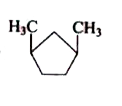Which one of the following will be able to show cis-trans isomerism ?
Ma3b
M(AA)2
M(AB)(CD)
Ma4
The correct Answer is:C
To determine which of the given coordination compounds can show cis-trans isomerism, we will analyze each option step by step.
Step 1: Understand the concept of cis-trans isomerism
Cis-trans isomerism occurs in coordination compounds when there are different ligands attached to the central metal ion, and the spatial arrangement of these ligands can differ. Typically, this is observed in square planar and octahedral complexes.
Step 2: Analyze the options
1. Option A: MA3B
- This complex has three identical ligands (A) and one different ligand (B).
- In this case, regardless of how the ligands are arranged, the position of B relative to A will not create distinct isomers because all A ligands are equivalent.
- Conclusion: Does not show cis-trans isomerism.
2. Option B: MA2A2
- This complex has two identical bidentate ligands (A) and two identical ligands (A).
- Since all A ligands are identical, rearranging them does not yield different spatial arrangements.
- Conclusion: Does not show cis-trans isomerism.
3. Option C: MABCD
- This complex has two different bidentate ligands (AB) and (CD).
- The arrangement of these ligands can lead to different spatial configurations.
- For example, if we have AB on one side and CD on the other, we can interchange them to create different isomers (cis and trans).
- Conclusion: Can show cis-trans isomerism.
4. Option D: MA4
- This complex has four identical ligands (A).
- Similar to option A, since all ligands are identical, rearranging them does not create distinct isomers.
- Conclusion: Does not show cis-trans isomerism.
Step 3: Final Conclusion
Based on the analysis of each option, the only compound that can show cis-trans isomerism is Option C: MABCD.
Summary of Steps:
1. Understand cis-trans isomerism.
2. Analyze each option for the potential to create different spatial arrangements.
3. Conclude that only MABCD can show cis-trans isomerism.
Cis-trans isomerism occurs in coordination compounds when there are different ligands attached to the central metal ion, and the spatial arrangement of these ligands can differ. Typically, this is observed in square planar and octahedral complexes.
1. Option A: MA3B
- This complex has three identical ligands (A) and one different ligand (B).
- In this case, regardless of how the ligands are arranged, the position of B relative to A will not create distinct isomers because all A ligands are equivalent.
- Conclusion: Does not show cis-trans isomerism.
- This complex has two identical bidentate ligands (A) and two identical ligands (A).
- Since all A ligands are identical, rearranging them does not yield different spatial arrangements.
- Conclusion: Does not show cis-trans isomerism.
- This complex has two different bidentate ligands (AB) and (CD).
- The arrangement of these ligands can lead to different spatial configurations.
- For example, if we have AB on one side and CD on the other, we can interchange them to create different isomers (cis and trans).
- Conclusion: Can show cis-trans isomerism.
- This complex has four identical ligands (A).
- Similar to option A, since all ligands are identical, rearranging them does not create distinct isomers.
- Conclusion: Does not show cis-trans isomerism.
Based on the analysis of each option, the only compound that can show cis-trans isomerism is Option C: MABCD.
1. Understand cis-trans isomerism.
2. Analyze each option for the potential to create different spatial arrangements.
3. Conclude that only MABCD can show cis-trans isomerism.
Topper's Solved these Questions
- BOOK - RESONANCE ENGLISHCHAPTER - COORDINATION COMPOUNDSEXERCISE - Additional Problem for Self Practice (APSP) Part-III Match the column1videos
COORDINATION COMPOUNDS
- BOOK - RESONANCE ENGLISHCHAPTER - COORDINATION COMPOUNDSEXERCISE - Additional Problem for Self Practice (APSP) Part-III Single and double value integer type11videos
COORDINATION COMPOUNDS
- BOOK - RESONANCE ENGLISHCHAPTER - COORDINATION COMPOUNDSEXERCISE - Additional Problem for Self Practice (APSP) Part-III Subjected Question7videos
COORDINATION COMPOUNDS
- BOOK - RESONANCE ENGLISHCHAPTER - CHEMISTRY IN EVERYDAY LIFEEXERCISE - ORGANIC CHEMISTRY(Chemistry in every day life)31videos
CHEMISTRY IN EVERYDAY LIFE
- BOOK - RESONANCE ENGLISHCHAPTER - D & F BLOCK ELEMENTSEXERCISE - ORGANIC CHEMISTRY(Aldehydes , Ketones, Carboxylic acid)15videos
D & F BLOCK ELEMENTS
Similar Questions
Knowledge Check
- Question 1 - Select One
Which of the following compounds will show cis-trans isomerism?
A(CH3)2C=CHC2H5BH2C=CCl2CCH3HC=CClCH3DHClC=CH2 - Question 2 - Select One or More
Which of the following cycloalkanes will show cis-trans isomerism?
A B
B C
C D
D
- Question 3 - Select One
Which one of the following compounds will show geometrical isomerism ?
ACH3−CH=CH2BCH3−C∣CH3=CH2CCH3−C∣CH3=CHDDCH3=CH=CHD
Which of the following compounds will show cis-trans isomerism?
(i) (CH3)2C=CH−C2H5
(ii) CH2=CBr2
(iii) C6H5CH=CH−CH3
CH3CH=CClCH3View SolutionWhich of the following will not show geometrical isomerism ?
View SolutionWhich of the following would exhibit cis-trans isomerism?
View SolutionWhich of the following will not show geometrical isomerism ?
View SolutionWhich of the following will not show geometrical isomerism ?
View Solution

